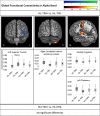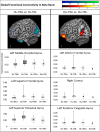Global resting-state functional connectivity of neural oscillations in tinnitus with and without hearing loss
- PMID: 32243040
- PMCID: PMC7294064
- DOI: 10.1002/hbm.24981
Global resting-state functional connectivity of neural oscillations in tinnitus with and without hearing loss
Abstract
This study examined global resting-state functional connectivity of neural oscillations in individuals with chronic tinnitus and normal and impaired hearing. We tested the hypothesis that distinct neural oscillatory networks are engaged in tinnitus with and without hearing loss. In both tinnitus groups, with and without hearing loss, we identified multiple frequency band-dependent regions of increased and decreased global functional connectivity. We also found that the auditory domain of tinnitus severity, assayed by the Tinnitus Functional Index, was associated with global functional connectivity in both auditory and nonauditory regions. These findings provide candidate biomarkers to target and monitor treatments for tinnitus with and without hearing loss.
Keywords: biomarkers; electroencephalography; functional brain imaging; hearing loss; magnetoencephalography; tinnitus.
© 2020 The Authors. Human Brain Mapping published by Wiley Periodicals, Inc.
Conflict of interest statement
The authors declare no potential conflict of interest.
Figures








Similar articles
-
Striatal networks for tinnitus treatment targeting.Hum Brain Mapp. 2022 Feb 1;43(2):633-646. doi: 10.1002/hbm.25676. Epub 2021 Oct 5. Hum Brain Mapp. 2022. PMID: 34609038 Free PMC article.
-
A 7 Tesla fMRI investigation of human tinnitus percept in cortical and subcortical auditory areas.Neuroimage Clin. 2020;25:102166. doi: 10.1016/j.nicl.2020.102166. Epub 2020 Jan 11. Neuroimage Clin. 2020. PMID: 31958686 Free PMC article.
-
Distress-dependent temporal variability of regions encoding domain-specific and domain-general behavioral manifestations of phantom percepts.Eur J Neurosci. 2018 Jul;48(2):1743-1764. doi: 10.1111/ejn.13988. Epub 2018 Jun 29. Eur J Neurosci. 2018. PMID: 29888410
-
Using resting state functional connectivity to unravel networks of tinnitus.Hear Res. 2014 Jan;307:153-62. doi: 10.1016/j.heares.2013.07.010. Epub 2013 Jul 26. Hear Res. 2014. PMID: 23895873 Review.
-
Neural networks of tinnitus in humans: Elucidating severity and habituation.Hear Res. 2016 Apr;334:37-48. doi: 10.1016/j.heares.2015.09.010. Epub 2015 Sep 28. Hear Res. 2016. PMID: 26415997 Review.
Cited by
-
Global MEG Resting State Functional Connectivity in Children with Autism and Sensory Processing Dysfunction.bioRxiv [Preprint]. 2024 Jan 29:2024.01.26.577499. doi: 10.1101/2024.01.26.577499. bioRxiv. 2024. PMID: 38352614 Free PMC article. Preprint.
-
Genetic architecture distinguishes tinnitus from hearing loss.Nat Commun. 2024 Jan 19;15(1):614. doi: 10.1038/s41467-024-44842-x. Nat Commun. 2024. PMID: 38242899 Free PMC article.
-
Hearing loss and tinnitus: association studies for complex-hearing disorders in mouse and man.Hum Genet. 2022 Apr;141(3-4):981-990. doi: 10.1007/s00439-021-02317-9. Epub 2021 Jul 27. Hum Genet. 2022. PMID: 34318347 Free PMC article. Review.
-
Reducing Tinnitus via Inhibitory Influence of the Sensorimotor System on Auditory Cortical Activity.J Neurosci. 2025 Apr 23;45(17):e0581242025. doi: 10.1523/JNEUROSCI.0581-24.2025. J Neurosci. 2025. PMID: 39952670
-
Multi-modal virtual reality system for tinnitus treatment methods and validation.PLoS One. 2025 Sep 8;20(9):e0330843. doi: 10.1371/journal.pone.0330843. eCollection 2025. PLoS One. 2025. PMID: 40920691 Free PMC article.
References
-
- Acoustical Society of America (ANSI) . (2004). American National Standards on acoustics. Melville, NY: Author.
-
- Adamchic, I. , Toth, T. , Hauptmann, C. , Walger, M. , Langguth, B. , Klingmann, I. , & Tass, P. A. (2017). Acute effects and after‐effects of acoustic coordinated reset neuromodulation in patients with chronic subjective tinnitus. NeuroImage: Clinical, 15, 541–558. 10.1016/j.nicl.2017.05.017 - DOI - PMC - PubMed
-
- Benjamini, Y. & Hochberg, Y. (1995). Controlling the false discovery rate: A practical and powerful approach to multiple testing. Journal of the Royal Statistical Society, 57, 289–300.
Publication types
MeSH terms
Grants and funding
LinkOut - more resources
Full Text Sources
Other Literature Sources
Medical

